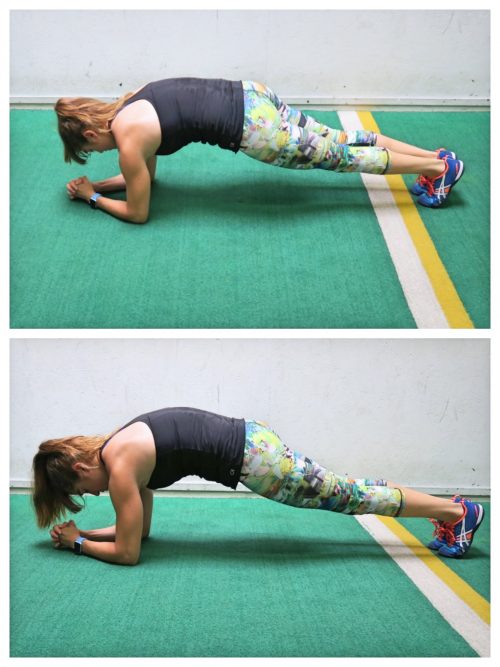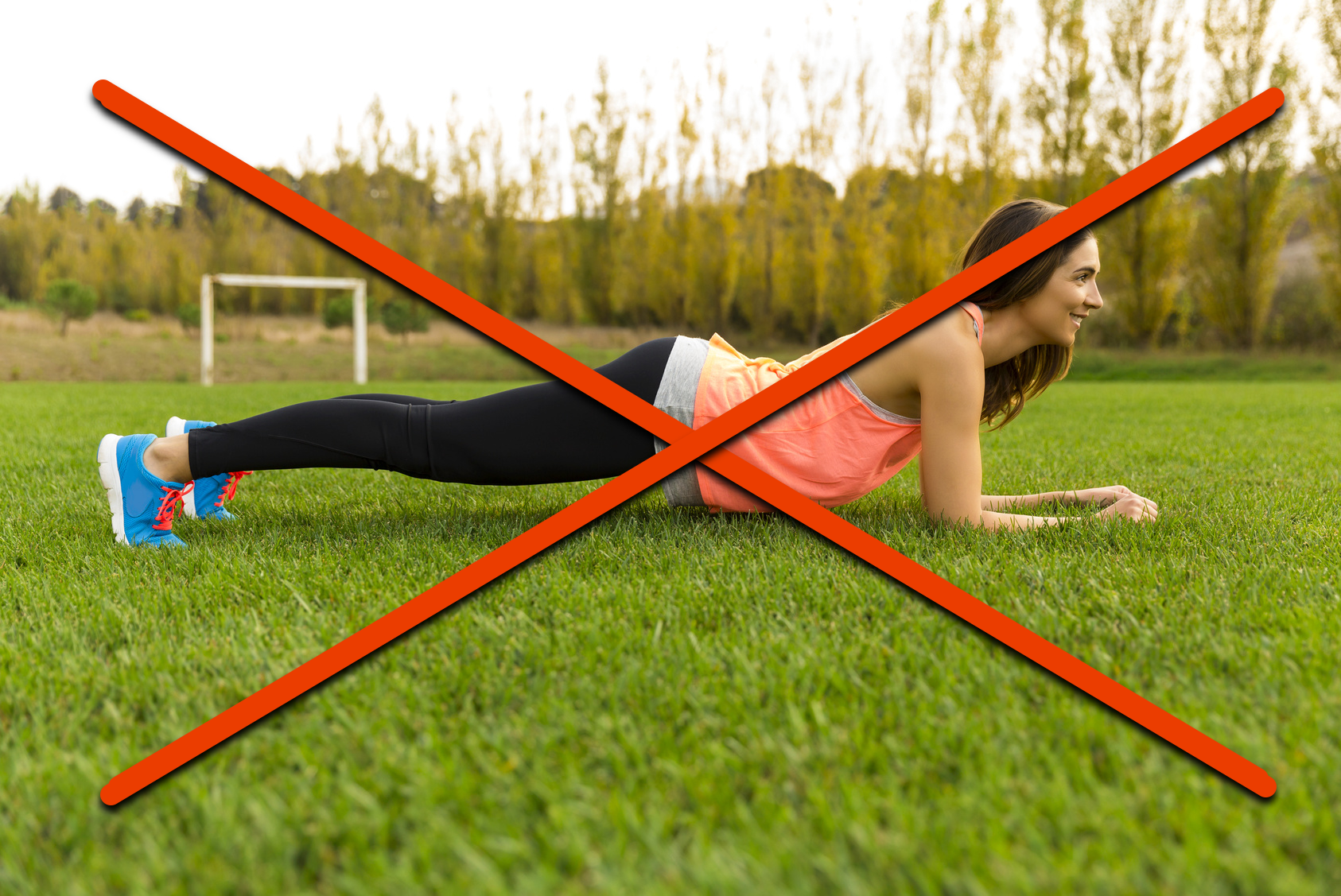Many believe the plank to be one of the best core exercises out there, but it’s has also become very overrated.
The plank has now become an overrated core exercise because most people use it incorrectly.
So maybe it isn’t the plank so much as people’s interpretation of the plank that is overrated…Either way…if you’re going to do them incorrectly, they are highly overrated!
How do people use the plank incorrectly?
They A. focus on holding it longer instead of engaging the correct muscles. B. keep holding it even when their low back is taking over. And C. don’t think of it as the full core exercise it truly is.
Seriously, why hold a plank for longer if you aren’t working the correct muscles and making your core stronger? Who the heck has time to waste!?!
Why wouldn’t you want to engage everything so well that your core is shaking within 15 seconds and you’re really feeling those planks work!?!
Well, if you actually want to get the most out of your planks and use them in a way that will actually benefit you and make your core stronger, you need to remember 3 Tips To Improve Your Planks:
- Learn how to properly brace your abs so that your low back doesn’t take over.
- Create shake-age as soon as possible vs. trying to hold as long as possible.
- Remember that planks should work everything between your shoulders and your knees!
Here’s how to implement these 3 tips to improve your planks.
1. Learn how to properly brace your abs so that your low back doesn’t take over.
If you’re feeling your low back taking over during planks, that means you aren’t doing them correctly…Plain and simple. This means you need to learn how to brace your abs or engage them with the pelvic tilt.
Why does your low back want to take over?
Often our abs are inactive and our hips are tight because of our modern lifestyle, which can cause our low back to do work that it shouldn’t, and can’t handle.
That is why you may need to focus extra hard and practice engaging or bracing your abs during planks. (That is also why you can’t care about how long you hold but should instead focus on how hard you can engage all of the muscles!)
One of the best and easiest ways if you struggle to get your abs engaged during planks is to perform a variation of the basic plank called a Plange Plank.

This variation looks so wrong because it has you actually round your back up toward the ceiling as you also draw your bellow button in toward your spine. It is a plank variation of the cat portion of cat/cow stretch (sometimes called vomiting cat), in which you are very focused on drawing your belly button in toward your spine as hard as you can.
If you do this correctly, your abs should almost instantly start to shake. You should be engaging your core as hard as you can.
From here you can learn to engage your abs without the rounding of the upper back. But until you can correctly engage your abs as hard as possible, start with the Plange Plank.
And if you struggle to even feel your abs working properly during the Plange Plank, maybe even regress to a pelvic tilt or the vomiting cat for a bit until you really can recruit the correct muscles!
2. Create shake-age as soon as possible vs. trying to hold as long as possible.
Shake-age is the highly technical term for when you engage your muscles so hard they begin to shake. If you can do this during planks in the first 15 seconds, I will be much more impressed than if you can hold for 3 hours while not actually engaging anything.
If you want to get the most out of the plank, engage everything as hard as you can. FOCUS on the muscles that should be working. That means engaging your abs, but also your back, quads, glutes, and adductors.
It means thinking about your body position and not simply holding for as long as you can.

Too often we repeat movements with no thought as to the muscles that should be working. And unfortunately, because of our modern lifestyle, we don’t always actually use the correct muscles.
Often our bodies take the path of least resistance and recruit muscles that shouldn’t be carrying the load that they are.
That is why you need to focus on the correct muscles working and even assess and try to recruit them harder as you hold. That is why it is way more impressive to have the mind-body connection to create shake-age because you are engaging everything so hard than it is to hold forever without using the right muscles.
Plus which do you think ACTUALLY gets you results? Holding for a long time without engaging the correct muscles or holding for 10 seconds while engaging the muscles so hard you’d think there was an earthquake under you….
I know which one I’ll be doing…
3. Remember that planks should work everything between your shoulders and your knees!
So two and three really go together. To create shake-age, you must remember to engage everything between your shoulders and your knees.
And this means setting up with proper plank form so that you can actually engage everything.
This means setting up in a plank from your forearms or hands with your hands or elbows stacked under your shoulders so you can properly engage your back to support your shoulders.
This means engaging your abs and not letting your low back arch. This means setting up in a plank with your feet together so you can squeeze your inner thighs together as you flex your glutes and quads. It means driving back through your heels as you hold without your elbows or hands getting out in front of your shoulders.
It means engaging everything between your shoulders and your knees as hard as you freaking can.
And often it means running through each piece as you hold to assess whether or not the correct muscles are actually working.
You can’t simply go through the motions!
If you want planks to work for you and get you results, you need to engage everything as hard as you can.
You can’t expect your abs or core to get stronger if you aren’t actually even forcing them to work!
So stop setting goals for how long you want to hold and instead focus on ab engagement, shake-age and building that mind-body connection so you can engage everything between your shoulders to your knees as hard as freaking possible.






Hi Cori thanks for all your help. I live in the uk how can get one of your t shirts?
Cori does it again! Excellent tips and the reminder that it is the quality of the movement that is more important than how long you can do an individual exercise/movement. I will be using these in my routines.
Hi Andy. When I get some new ones in, I’ll send it out in the newsletter. I’ve been slacking on this front recently and am currently out of stock. Stay tuned! 🙂
Thanks Manfred! Let me know how it goes. Definitely always quality of movement and engaging the correct muscles!
Cori, any idea why my bottom ankle collapses in side planks (ankle falls on the ground), and what to do about this? I’m generally strong and have been working out for many years now. Thanks!
Could you email me at [email protected] a picture so I can address the exact situation. Do you have weak ankles? Sounds like you may not be engaging all the way down to your foot and even driving through the outside of your foot in side plank. You may find rolling out the inside of your calf and doing some of these moves to strengthen the outside of your shins could help. https://www.youtube.com/watch?v=G0NUvvKHwEA
I like the emphasis on structure vs. time. Targeting work focus between two points to increase benefit really helps. I’m an old dude but not wanting low quality of life.
Thanks
Glad it’s helpful 🙂
Thanks for this.. very helpful! It’s so easy to just go thru the motions. I will be concentrating more now and taking this on board. Thank you!
Glad you enjoyed it! Definitely focus on that shakeage 🙂
Cori, I wanna ask something. When I reach the shakeage, am I have to stop the plank or keep going? Thanks
Hi Tika. You can definitely hold as you shake but stop immediately if you feel your lower back taking over or compensating.
I love your workout!but your hands in the forearm plank position are in wrong position. They should not touch each other and the palms shoud touch the ground
Thanks! But form is not black and white. Tell me why it’s wrong? Why do you use the other besides someone TELLING YOU it was right? I can tell you why I PREFER my variation. Our pecs are already overactive and most people struggle to engage their backs. I’ve found teaching it with hands together people are better able to engage their back and place less emphasis on their shoulders and pecs which tend to get strained with planks already (and often engage further with the other hand positioning). Maybe next time ask why someone is doing something over saying it is wrong. There are lot of VARIATIONS to moves that can work based on YOUR specific needs. We need to know that different variations can be used to get a better outcome based on individual needs.
I appreciate the article. I am curious if focusing on increasing the intensity can also translate into holding a plank for longer. The Navy has switched to the plank as their measure of core strength and it is scored by time. So, right or wrong, time is the goal. I worry about training one way and then trying to perform in a test a different way. Any insight would be appreciated.
Hi Donald. So it doesn’t have to be either or. BUT if you want to be the most effective at doing planks, why not only add time as you can truly engage muscles as intensely as possible? That way you can hold “better” for longer?